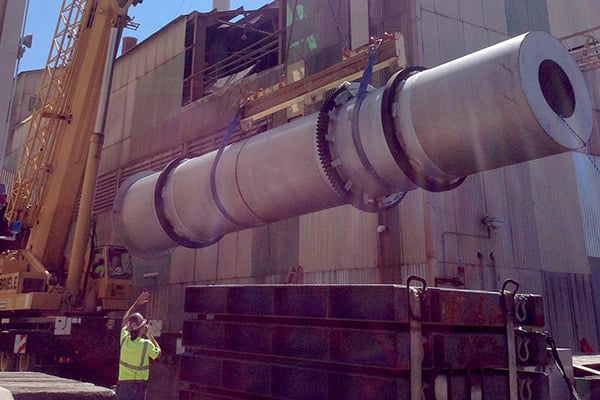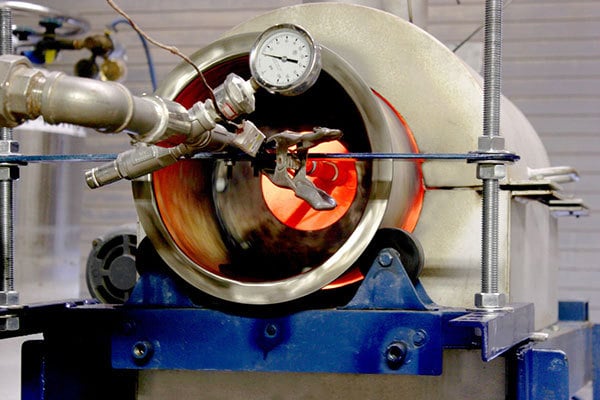Electronic waste, or e-waste, is continuing to capture global attention thanks to a litany of issues associated with the waste, ranging from environmental hazards to humanitarian concerns. As growing amounts of the waste add to fears of a looming crisis, efforts to recover valuable materials from e-waste continue to accelerate.
The rotary kiln, a highly engineered thermal processing device, looks to be a promising technology as “urban mining,” or the recovery of metals from e-waste, takes hold.
A Growing Sense of Urgency
As the world becomes more technologically connected than ever, volumes of e-waste are surging. According to recent statements by the World Economic Forum (WEF), e-waste now holds the title of fastest-growing global waste stream, having reached an alarming 48.5 million tons in 2018.
Further adding fuel to the fire, a recent report released by the Platform for Accelerating the Circular Economy (PACE) and the UN E-Waste Coalition estimates that without intervention, global e-waste production – the annual value of which they estimate to be around $62.5 billion dollars – could hit 120 million tons annually by 2050. According to the group, only 20% of e-waste is currently recycled.
This has prompted a growing sense of urgency for systemic change in the way the modern world approaches e-waste and the valuable finite resources we rely on.
The Case for Recycling E-waste
The disposal or improper recycling of such significant quantities is a double-edged sword; not only does it cause environmental and social harm, but it also takes critical, finite resources out of production.
Not unlike the broken nutrient cycle agriculture is currently grappling with, a closed-loop approach that extracts these valuable components for reuse is needed. Such an approach to e-waste could provide the following benefits:
- Discourage the improper recycling that goes on when e-waste is shipped to developing countries
- Alleviate associated water, soil, and air contamination risks
- Keep valuable secondary critical materials in production
- Reduce the need to mine finite resources
- Decrease the carbon footprint of obtaining these materials (Some experts estimate that recovering gold from e-waste results in 80% fewer carbon dioxide emissions compared to traditional mining.)
The economics (among other things) have been a deterrent to widespread adoption, but a recent report published in Environmental Science & Technology, entitled “Urban Mining of E-Waste is Becoming More Cost Effective Than Virgin Mining,” shows that the economics of such an endeavor can work. Albeit limited to the recovery of copper and gold from TV sets, the study used real cost data to illustrate that recovery costs were comparable to mining virgin ores. Urban mining is also more efficient, because e-waste is a much richer source of material compared to raw ore.
Further, widespread implementation would also likely have a number of indirect economic benefits as well, encouraging innovative technologies and creating new jobs.
Rotary Kilns for Recycling E-Waste
While more than just advancements in technology are needed, the use of the rotary kiln looks to offer a promising approach to economic e-waste recycling.
The rotary kiln is a high-temperature device employed to cause a chemical reaction or physical change in a material. Increasingly used in waste-to-value applications, rotary kilns are particularly effective when it comes to recovering metals, such as those contained in e-waste.
In recovering metals from e-waste, the kiln serves to volatilize the plastic and combustible components, leaving behind ash from which the metal(s) can then be leached. Electronic circuit boards, lithium batteries, and more, have all been effectively processed in a rotary kiln to recover once-contained metals such as lithium, copper, gold, nickel, and silver.
While alternatives to the rotary kiln are available, the advantage of the rotary kiln in this setting is that it is a truly continuous operation; other devices are batch style, requiring operators to load the system, run it, unload it, and then repeat the process. Rotary kilns are more efficient from an operational standpoint, because they avoid all of this; material is continuously fed into and discharged from the kiln, creating an efficient and high-capacity processing line.
E-Waste Kiln Design
Rotary kilns are incredibly customizable machines and can be engineered to suit the exact needs of the project at hand. In processing e-waste, the kiln may be either of the direct-fired or indirect-fired configuration.
Direct-fired Kilns
Direct-fired kilns employ combustion gases to process material through direct contact. This setup is more cost-effective and more efficient, but has a potential disadvantage: some of the metal can end up volatilizing with the combustible portion of the feed stream and exiting the system through the stack, resulting in some metal loss.

A FEECO direct-fired rotary kiln is prepared for installation.
Indirect-fired Kilns (aka Calciners)
Conversely, indirect-fired kilns, also often called calciners, are heated externally, so gases are kept separate from the material. Material is subsequently heated through contact with the shell of the rotating drum.
Although less thermally efficient, the use of an indirect kiln reduces the amount of metals lost to the stack. Additionally, this system generates syn-gas that can be used to fuel a fire in a boiler, to make steam, or even in a thermal oxidizer to generate a hot gas for heat recovery applications.
With either configuration, the recovery can be optimized through a variety of design considerations, which are typically determined through testing.
E-Waste Recycling Process Development
Testing in a facility such as the FEECO Innovation Center is often an essential part of developing a successful commercial-scale operation to recover metals from an e-waste stream.

Indirect-fired batch kiln used for testing e-waste in the FEECO Innovation Center
The characteristics of the specific waste stream and the target metal(s) can be tested in order to work out the process variables necessary for optimal recovery, or simply to validate yield. Variables typically include:
- Retention time
- Temperature profiles
- Rotational speed
- Feed rate
- Air flow velocity
- And more…
In addition to gathering the process data necessary for scale up, testing also allows for system off gases to be analyzed and characterized so the appropriate air pollution control equipment can be selected.
Test kilns are available in The Innovation Center in batch and pilot scale in both direct and indirect configurations.
Conclusion
The growing amount of e-waste produced each year is alarming and continues to draw concern, given the many environmental, resource, and social issues associated with its inadequate recycling.
The ability to recover critical raw materials from e-waste on a global scale would resolve these issues, while also keeping these much-needed resources in the production lifecycle. Rotary kilns offer a high-capacity, continuous, and optimized solution for e-waste recycling initiatives.
With the help of our testing facility, FEECO engineers and manufactures custom rotary kilns for recovering metals from e-waste. We have worked with a number of successful metal recovery projects in the effort to reuse the valuable components contained within this ever-increasing waste stream. For more information on our e-waste processing capabilities, contact us today!



